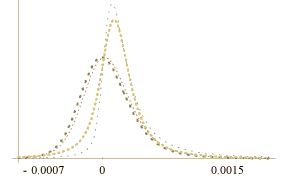Uncertainty: Risk in Real Estate
 The two parameter (mean and standard deviation) model widely used to measure risk in financial assets fares poorly in real estate applications. For a century of study, data needed to develop a formal real estate risk model has been lacking. Data is now available and the use of that data with fast, inexpensive computing power provides insight into real estate risk for the first time. Forty years ago when a database was three comparable sales and the tool of choice was a #2 lead pencil, describing risk on the back of the envelope was acceptable. Today, every well schooled real estate investor has at least128 MB of RAM on his desk and access to large amounts of data. As the industry formalizes the use of that data the public demands enhanced due diligence in the risk measurement area.
The two parameter (mean and standard deviation) model widely used to measure risk in financial assets fares poorly in real estate applications. For a century of study, data needed to develop a formal real estate risk model has been lacking. Data is now available and the use of that data with fast, inexpensive computing power provides insight into real estate risk for the first time. Forty years ago when a database was three comparable sales and the tool of choice was a #2 lead pencil, describing risk on the back of the envelope was acceptable. Today, every well schooled real estate investor has at least128 MB of RAM on his desk and access to large amounts of data. As the industry formalizes the use of that data the public demands enhanced due diligence in the risk measurement area.
A four parameter model has been proposed that considers extreme values (observations in the tail of the probability distribution) and skewness (non-symmetrical probability mass). These technical terms are nothing more than formal ways of responding to the common street question: "What are the chances of that?"
The graphic above (produced with data courtesy of The CoStar Group) illustrates unique aspects of a large number of real estate returns in 9 cities. Note the pronounced heavy right tail. If persistent, this result has important implications for understanding the risk of real estate investing.
